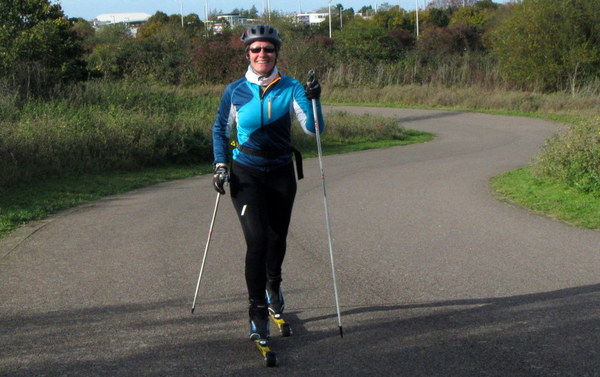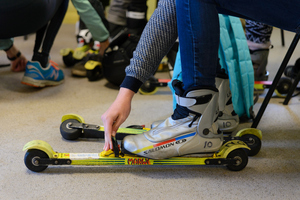About roller skiing
 Classic roller skiing [Photo: M Wray]Rollerskiing is:
Classic roller skiing [Photo: M Wray]Rollerskiing is:
- the ideal introduction to cross country [nordic] skiing without snow
- great for fitness - it's a full body workout for every skier
- fun and enjoyable exercise, and a sport in it's own right
- cross training for any endurance-based sport
- an opportunity to compete if you like racing
- the best preparation if you want to participate in iconic events like the Swedish 90km Vasaloppet cross country ski race.
Like cross country skiing, it's the most effective full body workout you can get. It exercises each major muscle group without the impact associated with running.
It builds balance, coordination and strength. It can also help those preparing for Alpine skiing, given the muscle groups it exercises.
As in cross country skiing on snow, you can learn two techniques - classic and skating. Classic is based on your natural walking movement and skate skiing is similar to ice skating or rollerblading. In both techniques you use poles to give you extra power and help push you along.
Roller skiing is also a competitive sport - from Club roller ski races throughout the UK to the FIS Rollerski World Cup series.
Where can you roller ski?
- Most roller skiing takes place on tarmac surfaces in parks, cycle paths and on quiet roads although you can also buy special kit for rough tracks or off road use.
- LRNSC members roller ski at the Club's main base in west London at Hillingdon Cycle Circuit and in the Cambridge area alongside the Busway. You can see all the venues members use here.
-
There's a useful Rollerski Directory that lists roller ski venues throughout the country.
Roller ski equipment
 Roller ski & boot - photo Andy Thompson, Sport EnglandYou need poles that have special tarmac-resistant tungsten tips and no baskets.
Roller ski & boot - photo Andy Thompson, Sport EnglandYou need poles that have special tarmac-resistant tungsten tips and no baskets.- Roller skis are around 70cm long, either metal or a compound, with two large wheels on each end.
- Wheels come in different sizes and materials to create slower skis for beginners and training or faster skis for racing.
- Wide wheels are used for classic skiing and thinner wheels for skate skiing
- The boots and bindings are the same as you use with cross country track skis.
- You can also get specific lighter weight roller ski boots for summer skiing.
- If you want to go off-road you'll need heavy duty roller skis called Skikes.
LRNSC courses include equipment hire and you can also hire kit for personal training at Club sessions.
If you want to buy your own kit, the best place to buy is online at Rollerski.co.uk, and occasionally the Club sells equipment to members. You can find further guidance on choosing roller skis, boots and protection in the Useful articles section.
Find out about our about our roller skiing sessions - there are tasters and courses for beginners and coaching for improvers, as well as opportunities for personal training/practice.
